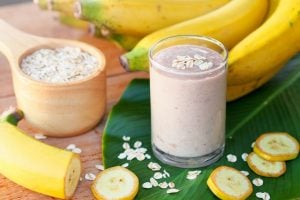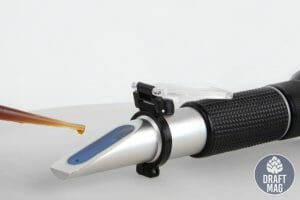Yeast Nutrient Substitute: Know the Best Yeast Nutrient Alternative
 The right yeast nutrient substitute can save your beer’s flavor by providing the nutrition that yeast requires for fermentation. If you’re new to brewing, you may or may not know that yeast nutrient serves as a rich source of energy for yeast. In its absence, the yeast won’t develop properly and even die, which will consequently affect fermentation.
The right yeast nutrient substitute can save your beer’s flavor by providing the nutrition that yeast requires for fermentation. If you’re new to brewing, you may or may not know that yeast nutrient serves as a rich source of energy for yeast. In its absence, the yeast won’t develop properly and even die, which will consequently affect fermentation.
So, if you don’t have yeast nutrients and look for an alternative, this post covers all that you should know.
Yeast Nutrient: What Is in Yeast Nutrient?
Yeast nutrient is crucial in making beers because it delivers many essential compounds that yeast requires. The compounds that yeast needs include nitrogen, amino acids, fatty acids, or vitamins. These things are involved in the formation of the new yeast cells that help it to thrive in the wort.
Yeast nutrient contains different compounds that provide yeast the nutrition it requires. The most common compounds that are present in yeast nutrients are:
– Diammonium Phosphate
Diammonium phosphate is a salt that acts as a source of free amino nitrogen (FAN). Nitrogen is an essential compound that yeast needs during fermentation. The presence of free nitrogen in the wort helps the yeast to perform various metabolic activities.
– Yeast Hulls
Yeast hulls are basically dead yeast that contains the nutrients required for new cell production. The primary nutrient that yeast hulls provide is lipids and fatty acids.
– Vitamins, Thiamine and Biotin
Vitamins, thiamine and biotin present in the yeast play a crucial role in the different metabolic processes of yeast. These nutrients mostly act as coenzymes and speed up the activity of yeast during fermentation.
– Magnesium, Zinc
Both magnesium and zinc increase the production of yeast cells, which in turn increases the fermentation rate.
Substitute for Yeast Nutrient: Which Options Do You Have?
Yeast nutrients work as a fertilizer for yeast to kick start or speed up the fermentation process. So, while looking for a substitute, you must remember that the yeast nutrient substitute should also increase the fermentation rate. Here are some things that can work as an excellent yeast nutrient alternative:
- Lemon juice
- Orange or lime juice
- A cup of chopped raisins
- A cup of strong black tea
- Bread yeast boiled in water for some time to kill it
- Grape nuts and rolled oats boiled in water
- Ripe bananas that are mashed up, boiled, strained, and the liquid added
Brewer’s Yeast – Overall the Best Yeast Nutrient Substitute
The substitutes mentioned before are a suitable replacement for yeast nutrients. But, if you want the best, then you should opt for brewer’s yeast. It helps in increasing the fermentation rate the same way yeast nutrient does. This is because they share a common origin, derived from the same fungus.
As the name indicates, brewer’s yeast is added during the fermentation of beer. In the presence of brewer’s yeast, there is no need to add any yeast nutrients. It’s strong enough to carry out the fermentation at the desired rate. So, if you don’t have yeast nutrients, then instead of mixing one or two nutrients as a substitute, you can add brewer’s yeast alone.
Can You Make Yeast Nutrient at Home?
Yes, you can make yeast nutrients at home. The process is fairly simple and involves easily accessible ingredients. The amount you produce depends entirely on your requirements, so you can increase or decrease the amount of the ingredients.
How To Make Homemade Yeast Nutrient?
The ingredients required and step by step process to make homemade yeast nutrient is given below:
 – Ingredients for Yeast Nutrient
– Ingredients for Yeast Nutrient
- 2 liters water
- 1 cup whole wheat, cracked or rolled
- 1 cup whole oats, cracked or rolled
- 1 cup whole barley, cracked or rolled
- 1 cup raisins diced or crushed
- 1 cup banana diced with peel
- 1 cup diced tomatoes, fresh or canned
- 1 tea bag
– Procedure To Make Yeast Nutrient
Start with adding water, tomatoes, wheat, oats, barley, raisins, and bananas in a pot. Heat the mixture at a high flame for some time. After that, simmer at low flame for about 30 minutes.
- After 30 minutes, remove the pot from heat and add a tea bag into it.
- Allow the pot mixture to cool for an hour.
- Filter the liquid with the help of a strainer and put it aside.
- Keep it in the refrigerator to use as a yeast nutrient anytime.
What Are Primary Yeast Nutrients?
Yeast nutrients provide nitrogen to the yeast for fermentation. The nitrogen provided to the yeast by the yeast nutrients consists of ammonia and different amino acids. The amino acids are collectively known as “free alpha-amino acids” or FAN. From these amino acids, some provide nitrogen for yeast metabolism. These nitrogen-delivering amino acids during fermentation are called primary yeast nutrients.
Can Old Yeast Be Used as a Yeast Nutrient?
Yes, old yeast can be used as a yeast nutrient. Old or dead yeast is a good source of many micronutrients as well as macronutrients. A combination of all these essential nutrients makes it a good substitute for nutrient yeast.
When It’s Not Necessary To Use Yeast Nutrient?
If you brew a beer with nutrient-rich grains, then there is no need to add yeast nutrients. The grains produce enough nutrients to promote healthy yeast production in the wort. In that case, it will not be necessary to use yeast nutrients.
For example, if malted barley is used for brewing, the yeast will get all the required nutrients from the compounds produced during fermentation. So, the addition of yeast nutrients will be of no use. Feel free to skip that step!
When To Use Yeast Nutrients in Beer Making?
While brewing beer, you’ll have to use yeast nutrient to provide food for your yeast in the following cases.
– Brewing a High Gravity Beer
A gravity beer produces more alcohol as a result of rapid fermentation. All the yeasts present in the wort can tolerate alcohol up to a specific level. If the alcohol exceeds the tolerance limit of yeast, it becomes difficult for it to handle the stress. As a result, fermentation can stop.
In such cases, you can use yeast nutrients to ensure that yeast gets enough energy during fermentation, so that the process can continue.
– Brewing a Beer With a High Proportion of Adjuncts
If a beer contains a high proportion of adjuncts, then you’ll need yeast nutrients. For example, if plain sugar is used as an adjunct and is responsible for more than 25 percent of the fermentation, your yeast won’t get sufficient nutrition. This is because sugar lacks real nutrients to promote the development of yeast. So, adding yeast nutrient during fermentation will become essential in this case.
What’s the Best Time To Add Yeast Nutrients to the Wort?
Yeast nutrient promotes fermentation, so the best time to add nutrients is at the start of the fermentation. You can also add it midway if the fermentation has stopped due to a shortage of yeast nutrients.
Can You Use Too Many Yeast Nutrients?
No, you can’t use too many yeast nutrients. You may think that it’s a fermentation booster, so adding a higher amount will make beer quicker.
However, it is still best to regulate the addition of yeast nutrients in wort. This is because the presence of too much yeast nutrient — we are referring to a very large amount – produces an organic compound called ethyl carbamate. The higher levels of this compound are associated with cancer in humans. So, the levels of yeast nutrients should be checked frequently during fermentation.
How Much Yeast Nutrient Is Safe To Use?
The safe amount of yeast nutrient is 1 gram per liter or 1 tablespoon for 1 gallon. The dosages of the yeast nutrients are mentioned on their packings. So, you must always look at the recommendations and advice from the manufacturer of yeast nutrients.
Yeast Nutrient vs. Yeast Energizer: Are They the Same?
No, yeast nutrients and yeast energizers aren’t the same thing. They are different and have different effects on the rate of fermentation during brewing. If the fermentation stops during brewing, then yeast energizers are preferably used to start the fermentation again instead of yeast nutrients. However, if you have only yeast nutrient at hand, it won’t be much of an issue.
FAQ
Can you make wine without yeast nutrients?
Yes, wine can be made without yeast nutrients, but it may take longer and produce less desirable flavors.
What ingredients are in yeast nutrients?
Yeast nutrients typically contain a mix of nitrogen compounds, vitamins, and minerals, such as diammonium phosphate, magnesium sulfate, and thiamine.
Can lemon juice be used as yeast nutrients?
Yes, lemon juice can be used as a substitute for yeast nutrients due to its high levels of citric acid.
Conclusion
 Finding a suitable substitute for yeast nutrient is tricky, but now you have all the info it takes. After reading this article, yow you know that:
Finding a suitable substitute for yeast nutrient is tricky, but now you have all the info it takes. After reading this article, yow you know that:
- The best substitute for yeast nutrient is brewer’s yeast. Other substitutes include lemon juice, black tea, raisins, bread yeast, etc.
- An essential nutrient that yeast nutrient provides to yeast is nitrogen. Other important compounds include vitamins, fatty acids, and amino acids.
- You can make yeast nutrient at home with a simple process.
- Yeast nutrient isn’t required every time you’re brewing the beer, mainly if the grains provide enough nutrition to the yeast.
- The best time to add nutrient yeast is at the start of the fermentation and according to the recommended amount.
Once you’re confident that you know everything about yeast nutrients and their substitutes, you use them as per your requirement. Just make sure that you don’t exceed the recommended levels, as they negatively affect your health.

 – Ingredients for Yeast Nutrient
– Ingredients for Yeast Nutrient




